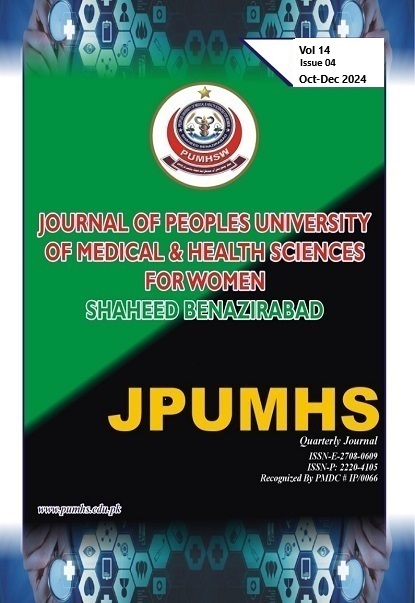RISK FACTORS AND OUTCOME OF OLIGOHYDRAMNIOS: OUR EXPERIENCE AT A TERTIARY CARE HOSPITAL.
JPUMHS;2024:14:04,250 257. http://doi.org/10.46536/jpumhs/2024/14.04.585
Keywords:
Oligohydramnios, PROM, C section, AFI, perinatal outcomes, NICU.Abstract
BACKGROUND: Oligohydramnios, the condition of having less than the normal volume of
amniotic fluid, is a complication of 1-5% of pregnancies. It is associated with high risks of
perinatal morbidity and mortality. It has many causes, often related to maternal factors like
hypertension, diabetes, post-term pregnancy, and premature rupture of membranes PROM.
Data with regards to the risk factors and neonatal outcomes in our region still seems
incomplete despite its significance in clinical practice. OBJECTIVE: To evaluate the risk
factors associated with oligohydramnios and analyze its impact on perinatal outcomes at a
tertiary care hospital. METHODS: This prospective observational study was carried out at
the Department of Obstetrics & Gynecology, Hayatabad Medical Complex Peshawar, from
1st March 2021 to March 2022. Total 152 pregnant women with oligohydramnios AFI ≤5 cm
or SDP <2 cm at ≥28 weeks gestation was enrolled. Data on demographics, risk factors,
ultrasound findings, delivery mode, and neonatal outcomes were recorded on a predefined
proforma. Statistical analysis was performed using SPSS 25.0. RESULTS: The mean
maternal age was 27.4 ± 4.8 years; 64.5% of women were aged 20–30 years. Hypertensive
disorders 30.3% were the most frequent maternal risk factor, followed by post-term
pregnancy 21.1% and PROM 18.4%. Isolated oligohydramnios occurred in 25.7% of cases.
Abnormal Doppler flow was found in 29.6%. Cesarean section was the commonest delivery
mode 58.6%, often due to fetal distress. Adverse outcomes included low birth weight 40.1%,
NICU admission 25.0%, low Apgar scores 14.5%, stillbirth 3.3%, and early neonatal death
2.0%. Hypertensive disorders, PROM, and abnormal Doppler flow were significantly
associated with poor perinatal outcomes. CONCLUSION: The presence of oligohydramnios
represents a high risk for negative perinatal outcomes, especially when linked with
hypertension, premature rupture of the membranes PROM, and abnormal fetal Doppler
ultrasound results. Early diagnosis and corrective actions are crucial in decreasing
complications and enhancing neonatal results.
Downloads
Downloads
Published
How to Cite
Issue
Section
License

This work is licensed under a Creative Commons Attribution-NoDerivatives 4.0 International License.




